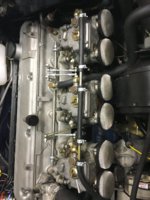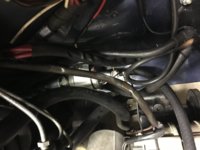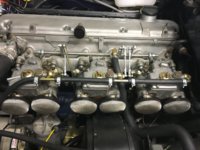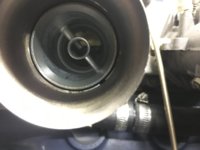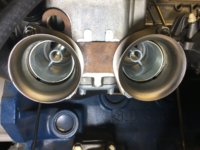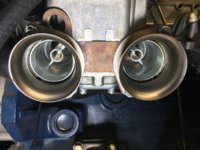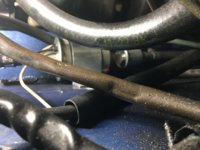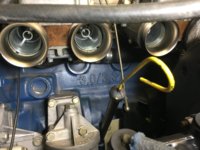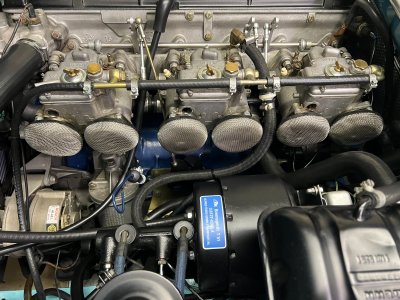You are using an out of date browser. It may not display this or other websites correctly.
You should upgrade or use an alternative browser.
You should upgrade or use an alternative browser.
Zen and the black art of triple Weber tuning (and other lessons learned along the way)
- Thread starter Stevehose
- Start date
Steve--The carb tech at Creative Workshop started my car after it had sat for about 2 weeks. He said it was hard to start and wants to put a choke cable on the cold start levers that I see have a thin wire connecting them in your photo. Doug McKenzie told me to look in the forum for use of a check valve in the fuel line,and no choke. That's how I found your post. I haven't driven the car much with all of the other sorting going on. I did feel a pop when in 2nd or 3rd at 2500 RPM. I have the 123 distrubutor installed. Here's a pic of the carbs with the new linkage installed. The carb parts and fuel pump were all bought from Pierce Manifolds. Please let me know what we should do about cold starts. It's hard to call any start cold here in South Florida. Thanks, DrewPart 3:
Tuning triple Webers is about compromise, it is difficult to get them to perform in all phases of operation: idle, off-idle, around town cruise, highway cruise, and WOT. They were designed for racing and WOT, not going to Starbucks like I use them for. So you may likely have an AFR scenario that will drive you nuts. For me it is low speed cruise, my AFR is between 12.2 and 12.7 around town in 2nd and 3rd gear. Same for highway at 60mph. At 80mph (the speed of traffic on the interstates in Louisiana) it is a delightful 13.5. WOT is 12.5. Idle is 12.5 (I’ve read M30’s like to run rich and with exhaust gas dilution etc. so don’t sweat the idle AFR as long as it’s not below 12). So decide which conditions you use most and tune accordingly, except always shoot for 12.5 on WOT so your engine doesn’t blow up. WOT means grit your teeth and foot to the floor! I don't recommend doing this test with your spouse or s/o in the car. Once you conciously do WOT tests you may realize how little you actually open the throttles all the way on your drives.
Try not to be a slave to the AFR gauge - also listen and feel how your engine runs (Zen) as it will tell you as much as the gauge once you know how rich and lean sound. I plan on removing the AFR gauge from it’s spot in the footwell so I can do more listening. On long trips I might have the gauge back out. My engine runs pretty well now and the plugs are a nice tan color so I am letting it go at that. Free at last. I think.
Temperature change can affect the AFR’s, the main jets in particular, I had to put smaller air corrector jets when the temps dropped below 60 degrees recently so consider this during the year depending on your climate. It’s normally 85-95 degrees when I drive so that’s what I originally jetted for. The idle mix screw may need a small tweak also. I don't have any experience with altitude changes but I suspect going over 3k feet would require a similar jet change.
Triples take some time to warm up before they behave civilly, generally they will pop and run lean and require pedal until warmed up which is a good sign that they are not jetted too richly. A couple pumps of the accell pedal is all I’ve ever needed to start them, even at 30 degrees. Once warm they will idle nicely.
Again, the 123ignition distributor is a godsend for DCOE’s because you can change the timing curve for adjusting idle speed, also giving the carbs’ their preference for extra advance early on, and the ability to change everything with a laptop in 1 minute which will be gold when you go to the dyno. You can also program a vacuum advance curve for some highway cruise efficiency if you have a vacuum source. It’s an amazing device.
I am still learning this stuff and will revise as new findings warrant. I hope other tuners will add contributions/experiences so we on the Dark Side have a decent M30 specific DCOE/DCOM reference. Enjoy the (intake) music!
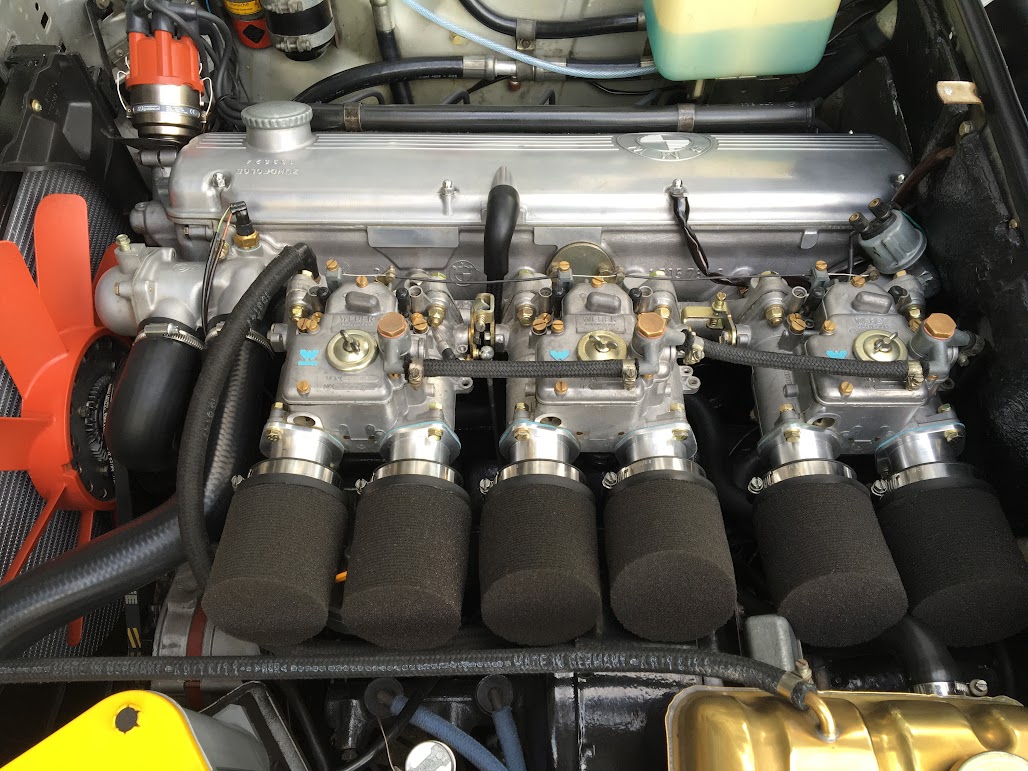
Attachments
Drew -- I'd be interested in Steve's take on this, but my view is that the primary difficulty in starting a car that is not run very often is evaporation of the fuel in the bowls. Obviously, there are places where vents are designed into the carbs to enable the use of the differential between engine vacuum and ambient air pressure to draw in air and emulsify fuel with the air. When the car sits, fuel evaporates through these vents.
I've addressed this problem with a fuel pump relay that injects three seconds into the carbs, filling the bowls, and three pumps on the pedal. My car fires up immediately, every time no matter how long it has been since I last drove it.
I don't have my cold start devices hooked up on my Webers; in fact I have removed them and blocked them off. In my view, they don't necessarily help the car start, they merely dump more fuel into the mix when you first get the car started causing the car to warm up faster until you turn them off.
The check valve will help keep fuel from draining back into the fuel tank, but because I think the problem is evaporation, I think a check valve is unlikely to provide a solution to the problem. I may be wrong about this, but I can tell you from experience that my solution works.
I've addressed this problem with a fuel pump relay that injects three seconds into the carbs, filling the bowls, and three pumps on the pedal. My car fires up immediately, every time no matter how long it has been since I last drove it.
I don't have my cold start devices hooked up on my Webers; in fact I have removed them and blocked them off. In my view, they don't necessarily help the car start, they merely dump more fuel into the mix when you first get the car started causing the car to warm up faster until you turn them off.
The check valve will help keep fuel from draining back into the fuel tank, but because I think the problem is evaporation, I think a check valve is unlikely to provide a solution to the problem. I may be wrong about this, but I can tell you from experience that my solution works.
Last edited:
Ohmess--Your solution seems to augment Steve's post. And experience is usually the best teacher. To be continued, DrewDrew -- I'd be interested in Steve's take on this, but my view is that the primary difficulty in starting a car that is not run very often is evaporation of the fuel in the bowls. Obviously, there are places where vents are designed into the carbs to enable the use of the differential between engine vacuum and ambient air pressure to draw in air and emulsify fuel with the air. When the car sits, fuel evaporates through these vents.
I've addressed this problem with a fuel pump relay that injects three seconds into the carbs, filling the bowls, and three pumps on the pedal. My car fires up immediately, every time no matter how long it has been since I last drove it.
I don't have my cold start devices hooked up on my Webers; in fact I have removed them and blocked them off. In my view, they don't necessarily help the car start, they merely dump more fuel into the mix when you first get the car started causing the car to warm up faster until you turn them off.
The check valve will help keep fuel from draining back into the fuel tank, but because I think the problem is evaporation, I think this a check valve is likely to provide a solution to the problem. I may be wrong about this, but I can tell you from experience that my solution works.
Definitely don't need the chokes hooked up as Ohmess mentions. Mine are also blocked off, the choke cable line you see is for looks only. We have similar climates and you'll never need the cold start circuit. Do you have a fuel pump relay/primer hooked up that primes the carbs for 3 seconds before cutting off if the ignition isn't on? This helps fill the bowls if empty. Otherwise I would pump the pedal a few times to get some gas through the accel pump jets with the fuel pump engaged before cranking. Try starting your car more often to see if this helps. Otherwise check the ignition and other tuning to make sure it's all good. The popping at 2500 rpm could either be carbs out of synch or a weak idle jet. Have the carbs been synchronized? What kind of fuel pump do you have?
Steve,- The tech at Creative has synchronized the carbs. The ignition has the 123 distr.,new wires and plugs. I will find out what fuel pump they bought from Pierce. I know Pierce recommended the type they installed in the engine compartment. On another carb topic,I have gone on a 10 mile drive and pulled into my garage. A few hours later, the gas smell is still prevalent,even in my connected garage that's 900 sq. feet. (that's where the 2002 and boat and workshop is). Is that gas smell typical with the 1973 carb set-up?Definitely don't need the chokes hooked up as Ohmess mentions. Mine are also blocked off, the choke cable line you see is for looks only. We have similar climates and you'll never need the cold start circuit. Do you have a fuel pump relay/primer hooked up that primes the carbs for 3 seconds before cutting off if the ignition isn't on? This helps fill the bowls if empty. Otherwise I would pump the pedal a few times to get some gas through the accel pump jets with the fuel pump engaged before cranking. Try starting your car more often to see if this helps. Otherwise check the ignition and other tuning to make sure it's all good. The popping at 2500 rpm could either be carbs out of synch or a weak idle jet. Have the carbs been synchronized? What kind of fuel pump do you have?
thanks,
Drew
If the fuel pump is in the engine compartment then perhaps a check valve would be helpful. Is the smell coming from the carbs? Any signs of seepage out of the top cover gaskets? I swapped out the crappy paper ones for the rubber ones form Pierce. Pricey but solves that problem. After a drive pull off the trumpet screens and look into the barrels with a flashlight to see if any gas is in there. In general, Webers will have some gas smells, depends on how much is too much.
I took the car out this morning for a 1/2 hour drive. Neighborhood 3rd gear 30 mph to highway burst to 90 mph. Pulled into the garage and pulled the carb screens and saw no gas evidence. The carb top gaskets looked ok also. Pics are below. There is a definite carb popping/backfire(?) at 2500 RPM while in 2nd or 3rd gear. I guess the gas smell is the small price we pay for garage enclosure. There is another pic of the Pierce fuel pump with an inline device to the right. I'll ask Creative Workshop if that is a filter or check valve.
Attachments
While taking the carb pics, I saw the block had 3.0/3.3 stamped on it. Korman Motorworks doesn't have records back to 2006 when they built this engine. The invoice doesn't specify the displacement either. They said it probably was a 3.2 or 3.3 liter. Any idea why the block has these markings?
Attachments
TodB
Well-Known Member
Apparently we married sistersBoth my wife and my dog think my car is too smelly.
Nice looking engine. I suppose having screens instead of foam might allow some residual fumes to escape more easily and thus the smell. If there are no visible leaks then just write it off as a small price to pay for that glorious intake noise! If the carbs are indeed synched (I'd verify that they are at 2500 rpm as well, not just idle) then it's either a fuel delivery or jetting issue for the popping. The crossbar linkage setup you have can be challenging to synch at all rpm's so I'd verify this first. It may be in synch at idle but can be off at 2500.
ROOTS.
New Member
Here’s my M30B30 on triple 45’s, Dbilas 288 cam, 123 ignition - but - standard exhaust manifold (for now). The car is RHD so big primary free flowing exhaust headers/manifolds are not easily found so I’m having one made!
car made 200whp and 200Ibs ft. Has some stumbling between 2-2800rpm but pull strong to 6200/6300 when power drops off. peak torque arrives at 4300rpm.
car made 200whp and 200Ibs ft. Has some stumbling between 2-2800rpm but pull strong to 6200/6300 when power drops off. peak torque arrives at 4300rpm.
Last edited:
Has anyone thought about making a six channel differential vacuum sensor? Seems like a pretty easy task. That way you could hook up the sensor, and see the difference between the reference carb and the others as changes are made. All without removing and re-positioning the CarbMate.
I have one and use it on my DCOM's:Has anyone thought about making a six channel differential vacuum sensor? Seems like a pretty easy task. That way you could hook up the sensor, and see the difference between the reference carb and the others as changes are made. All without removing and re-positioning the CarbMate.
Drew, I drove a BMW 2002 with dual DCOE's thru 3 Michigan winters, without ever once using the cold start feature. I had a cheap FACET cube style electric fuel pump. Even in well below freezing temps (parked outside), starting was easy. I would switch on the ignition, wait for the pump ticking to change tone (indicating the carb needle valves had closed), one pump of the accelerator pedal and the car would start up right away. I would have to sit and feather the pedal to keep the car idling (duration inversely proportional to temp). I think the key things were (1) Electric fuel pump, (2) Well adjusted carbs, (3) fresh points in the distributor. Nothing wrong with hooking up the cold start mechanisms, but generally speaking I don't think they are very useful and using them can lead to carbon buildup on your plugs.He said it was hard to start and wants to put a choke cable on the cold start levers that I see have a thin wire connecting them in your photo.
John
John, Cold start problem is a thing of the past for my engine. Chris told me how to buy the choke block off plates from Pierce a couple of years ago. Since my fuel pump and filter are on the driver side frame rail, all I do is pump the accelerator twice and start the car. I didn't have a cold start problem while at Hilton Head SC or Highlands, NC either. Temps were in the 50's and this coupe will not see Northern winters in my driving time. Keeping the idle at 1000 RPM with the A/C on with temps in the 80's-90's is my problem. Look at all of the room now with the Tii brake booster. Longer trumpets and 34mm chokes are next.
Attachments
and jettisoning those screensLonger trumpets and 34mm chokes are next.
Drew - Steve and I had a discussion of using a solenoid mounted near the bell crank that turns on with the a/c to bump up the idle speed when the a/c is running. Maybe Steve can jump in here. He probably took this further than I did.
Yep I sent him pics of my solenoid a ways back - Drew did you end up putting one in?Drew - Steve and I had a discussion of using a solenoid mounted near the bell crank that turns on with the a/c to bump up the idle speed when the a/c is running. Maybe Steve can jump in here. He probably took this further than I did.

